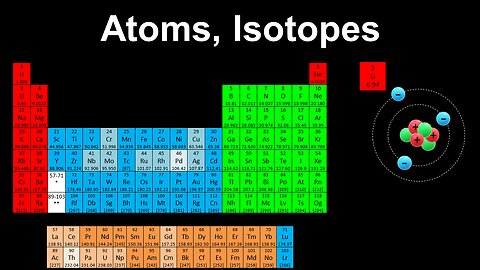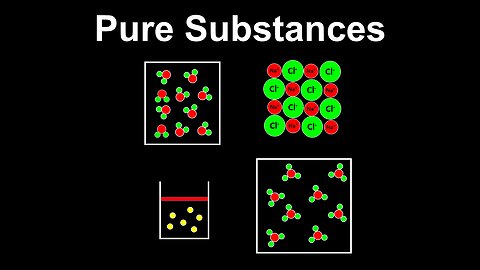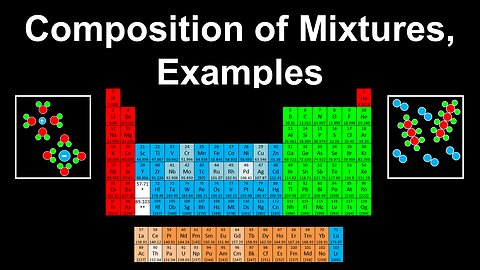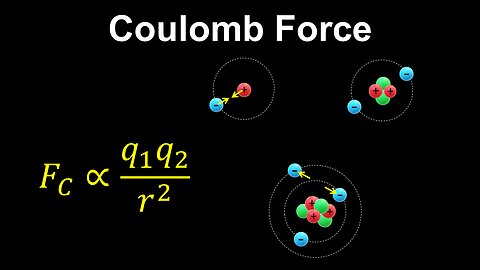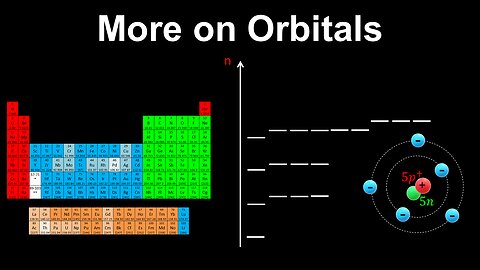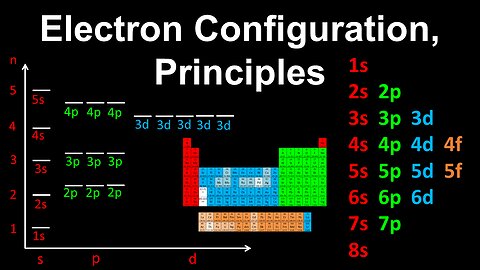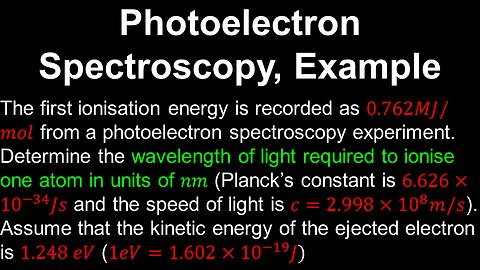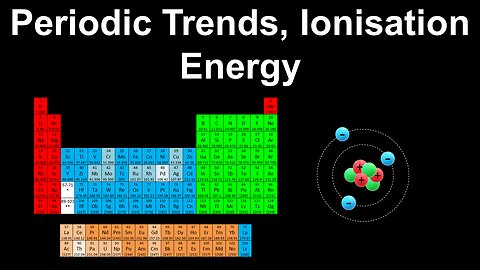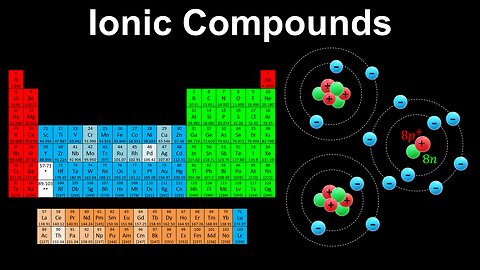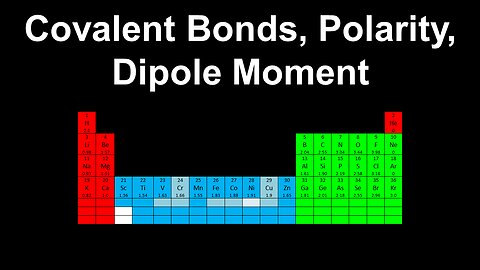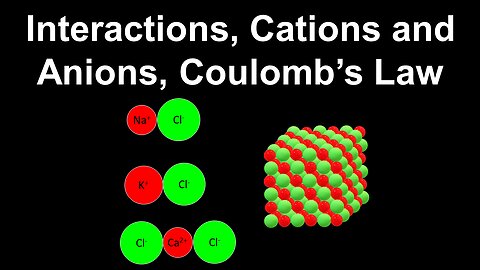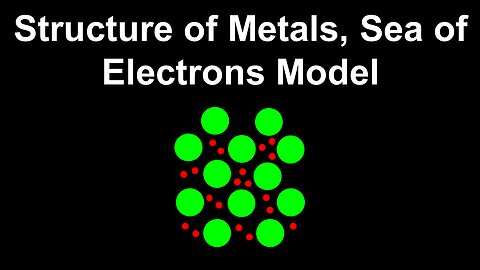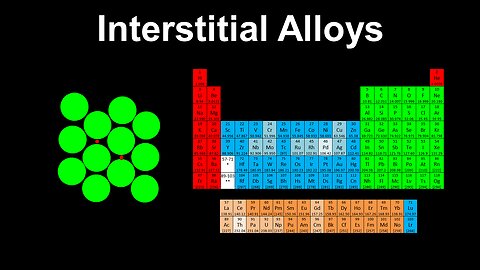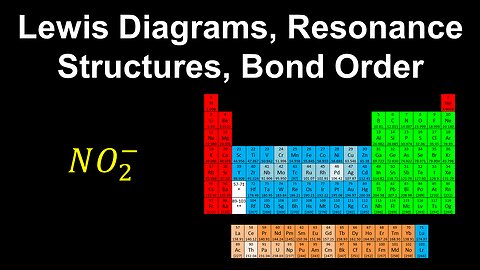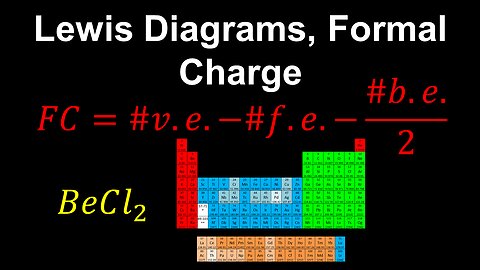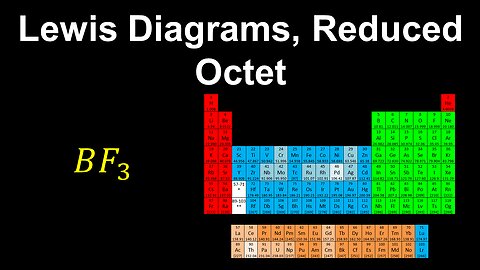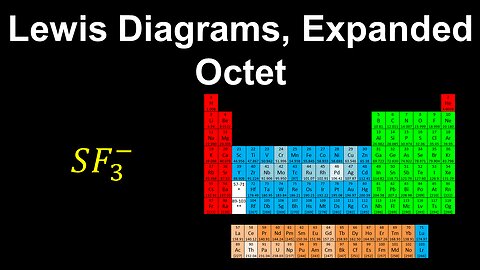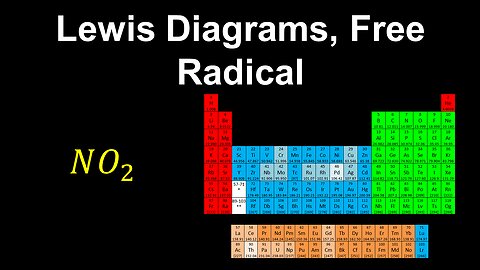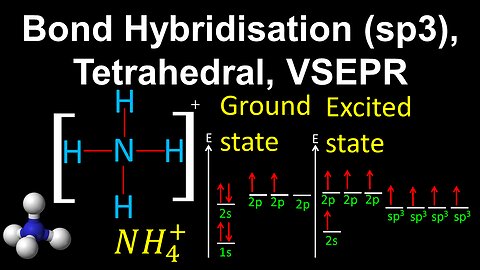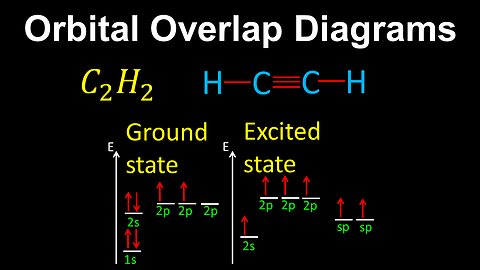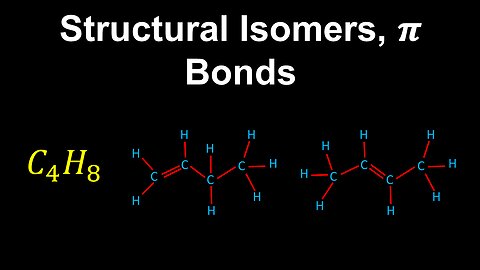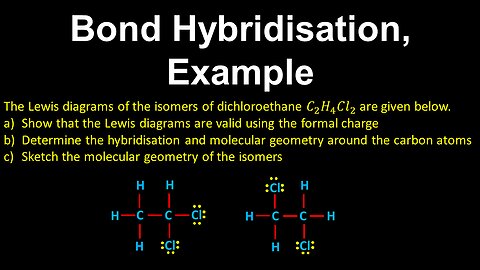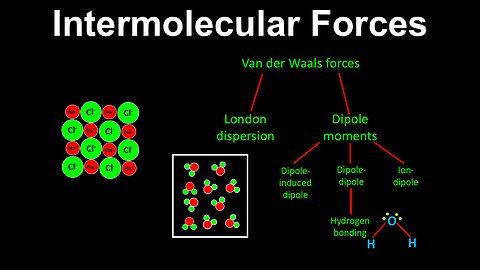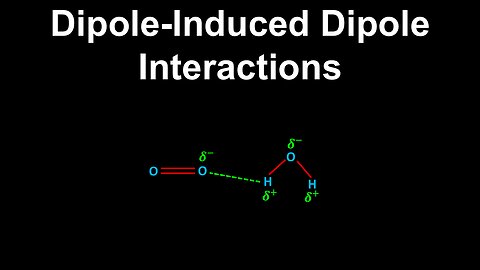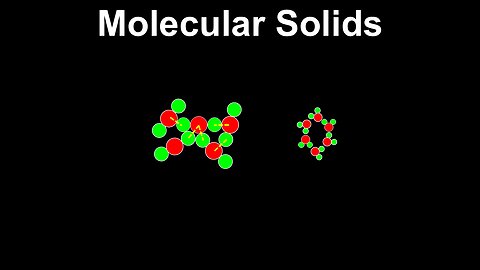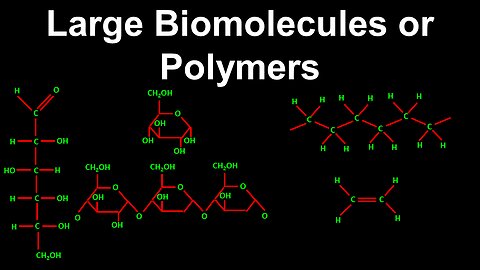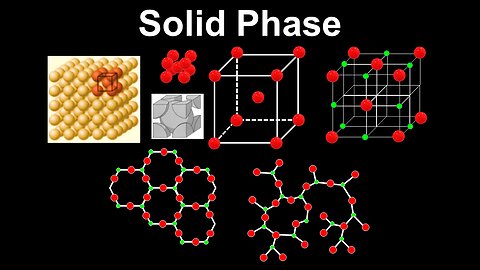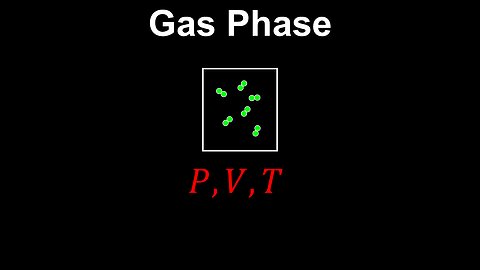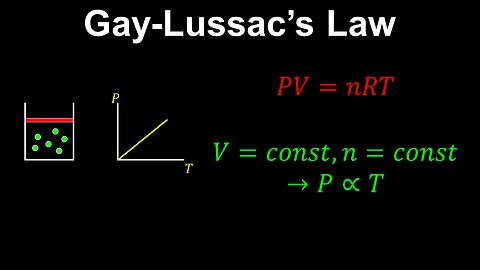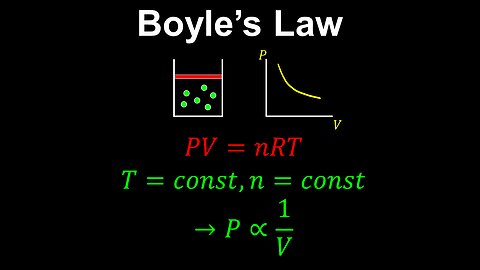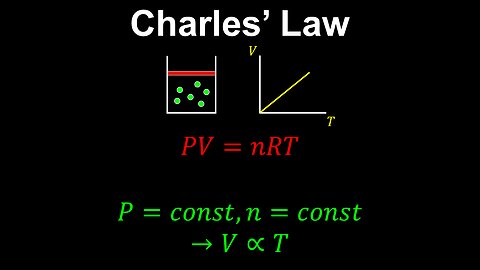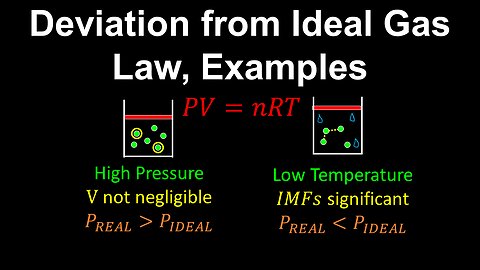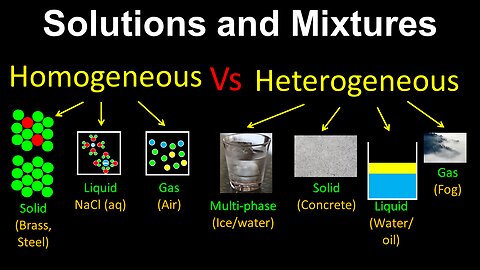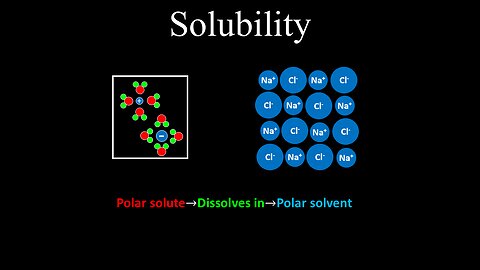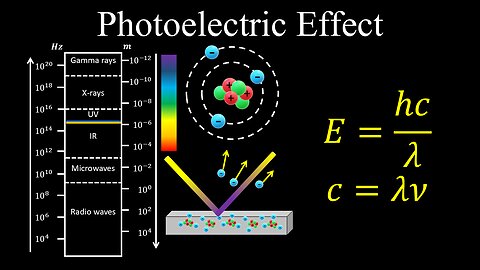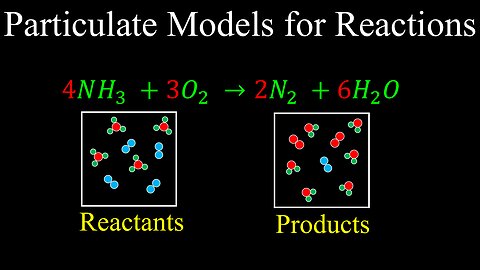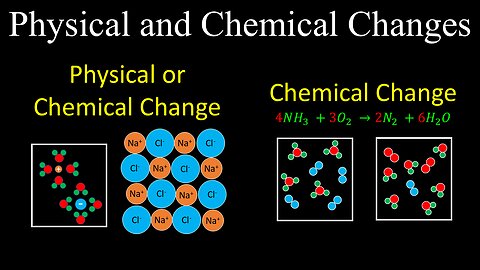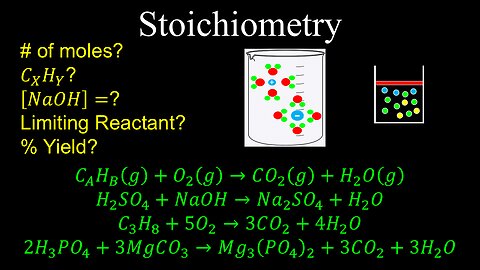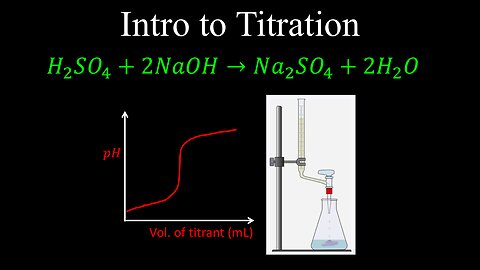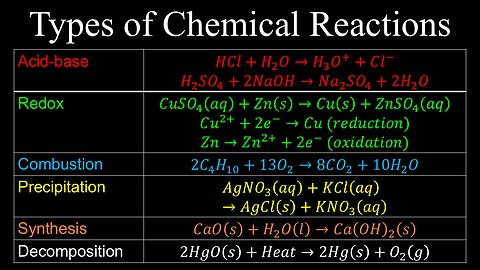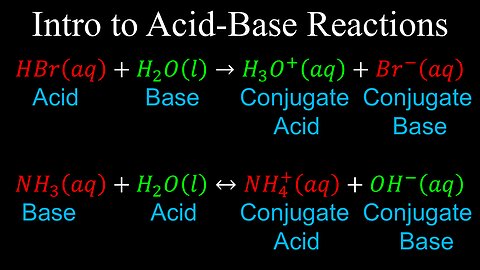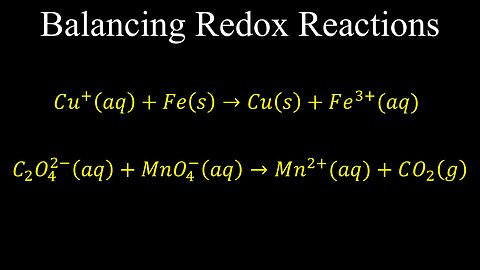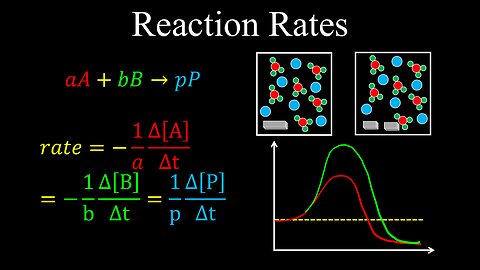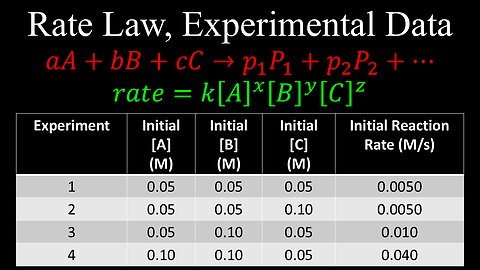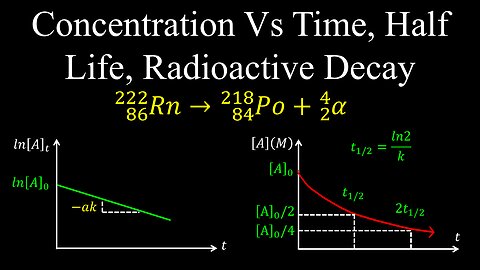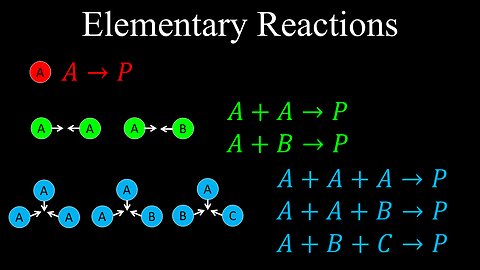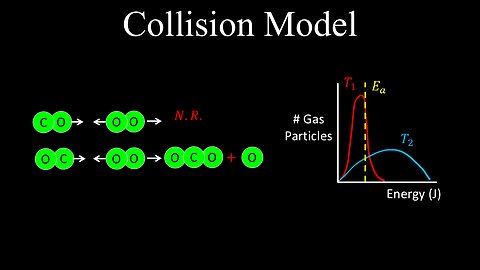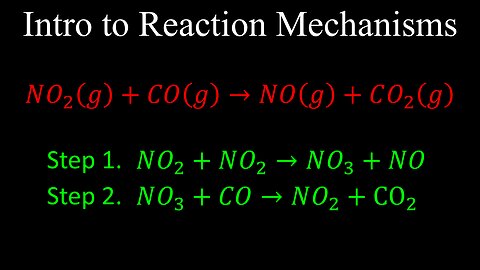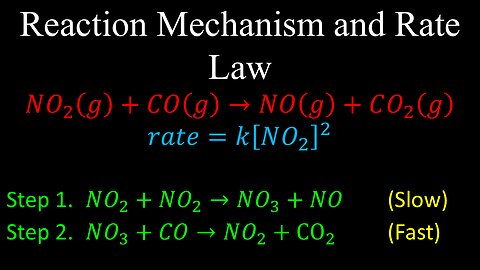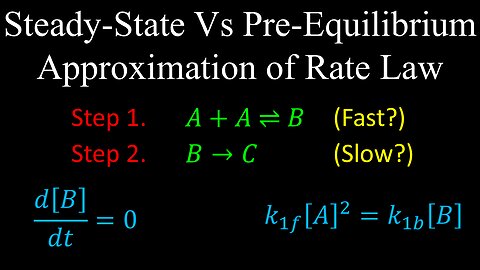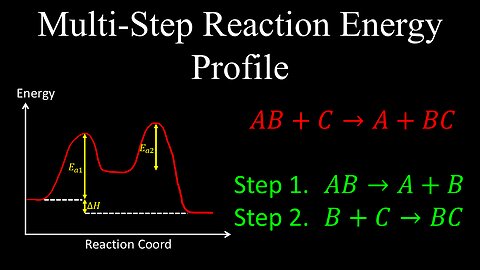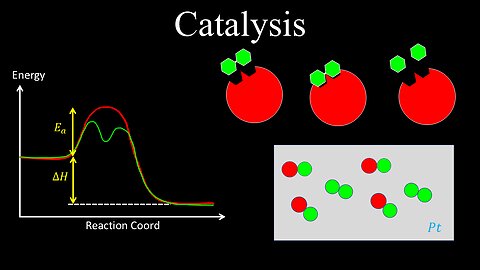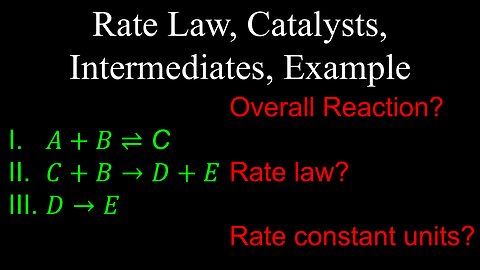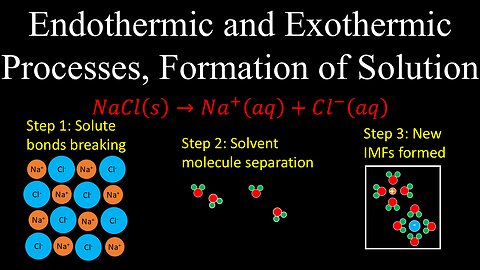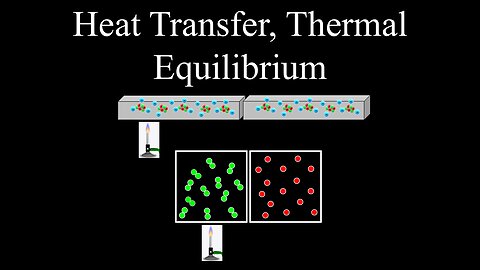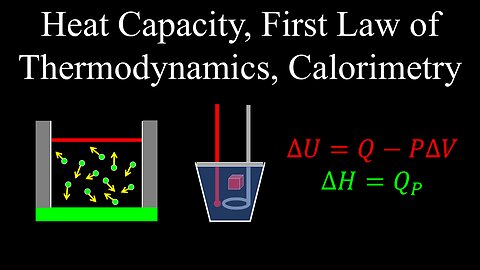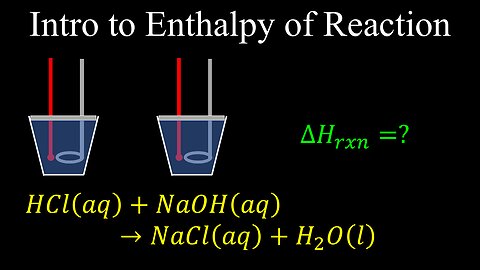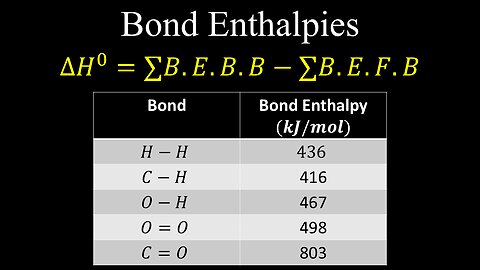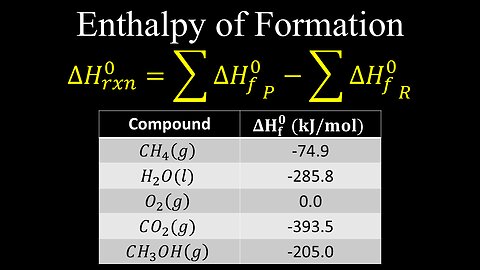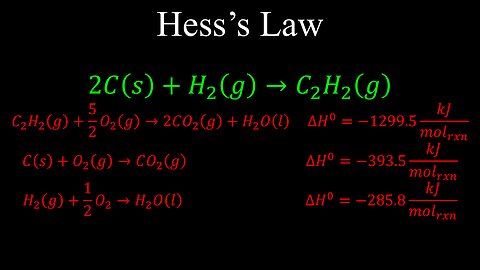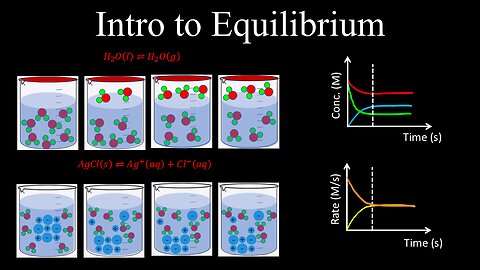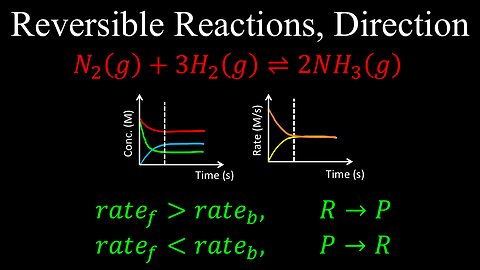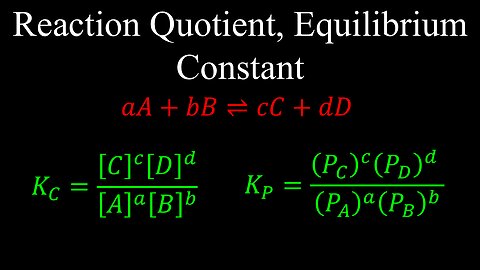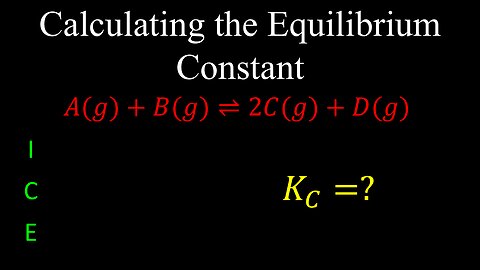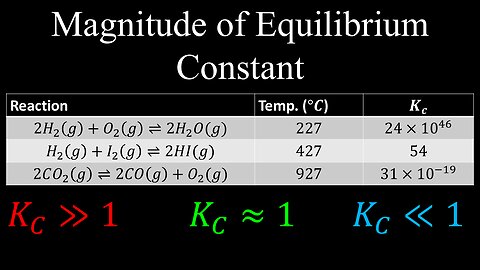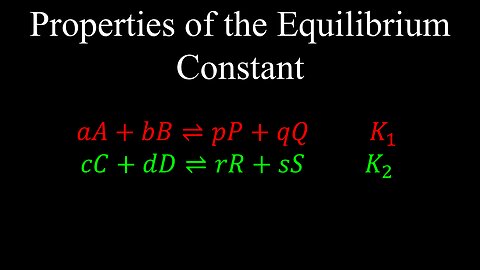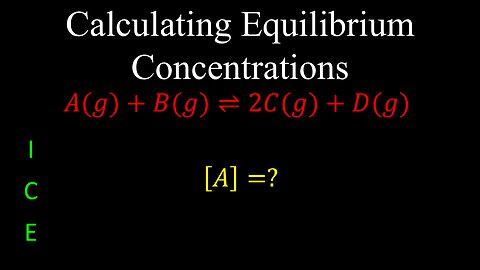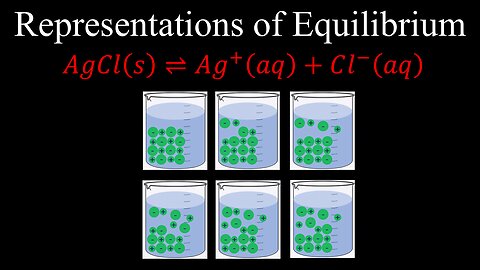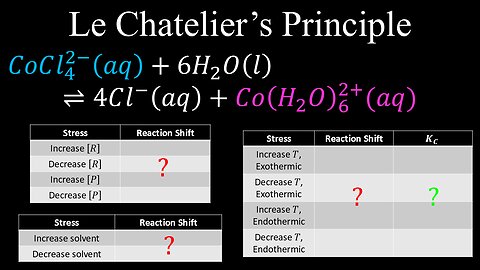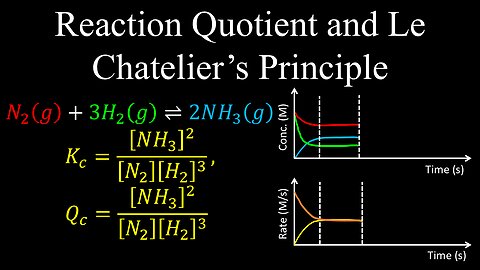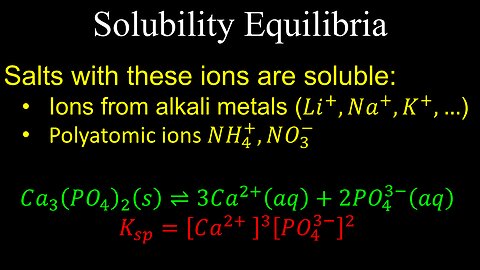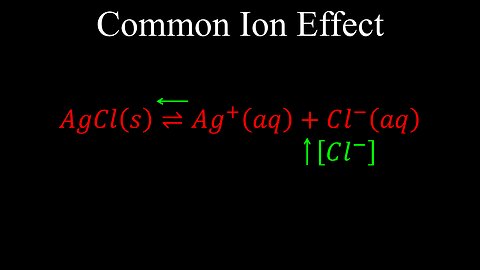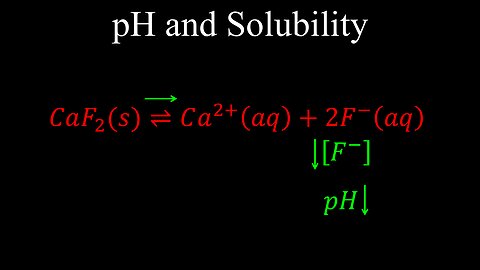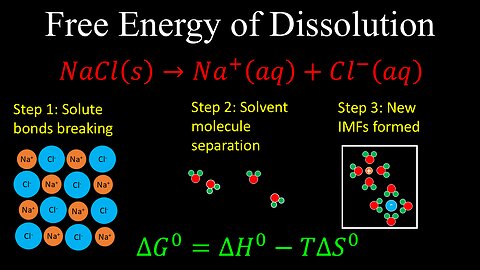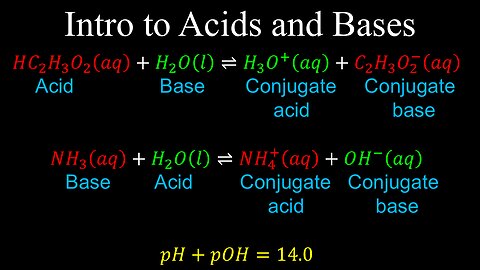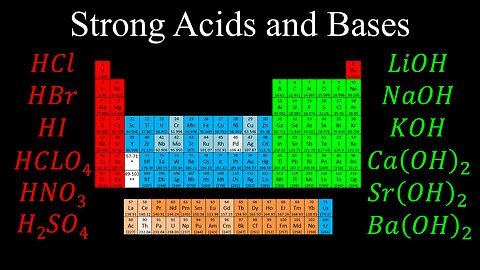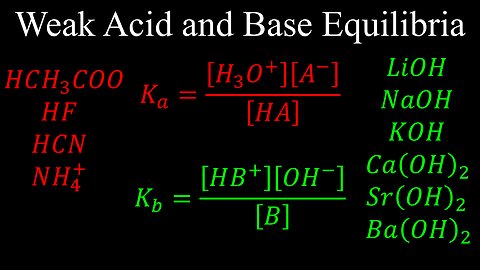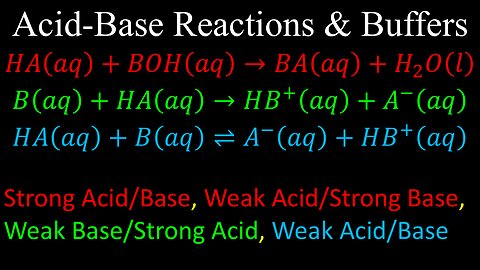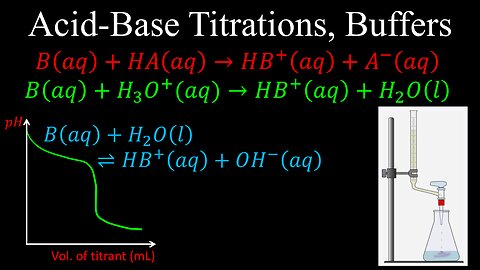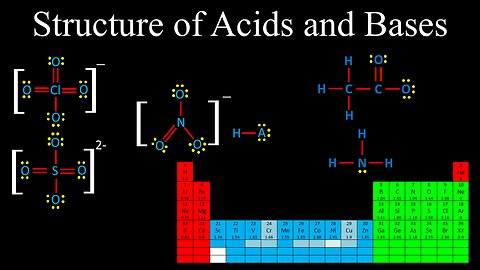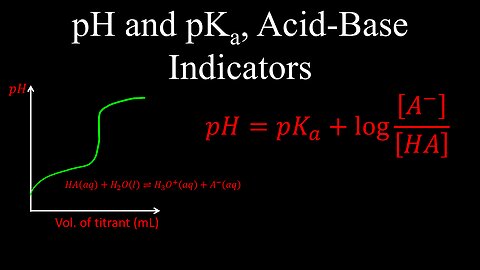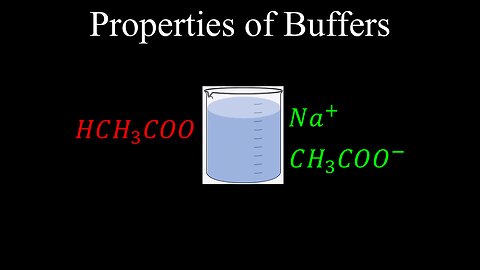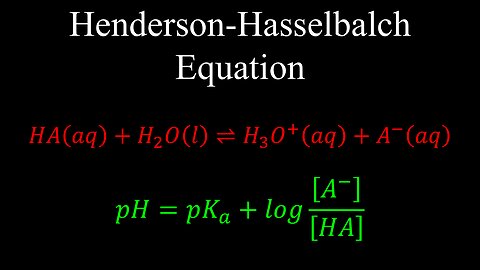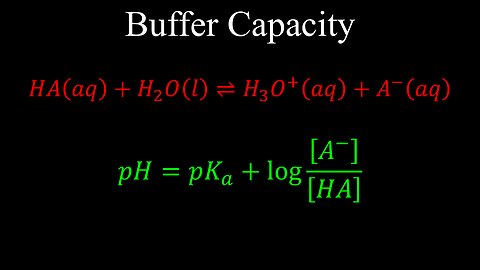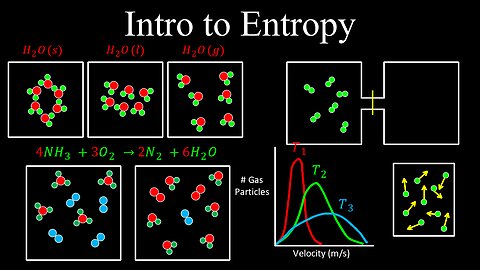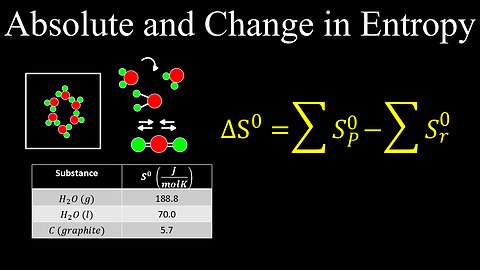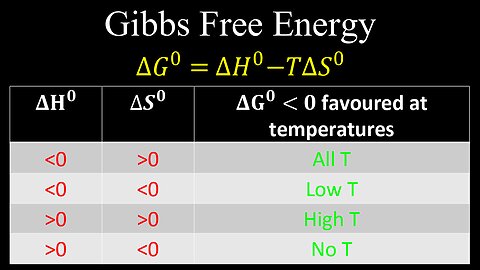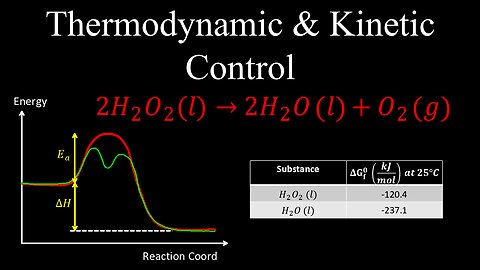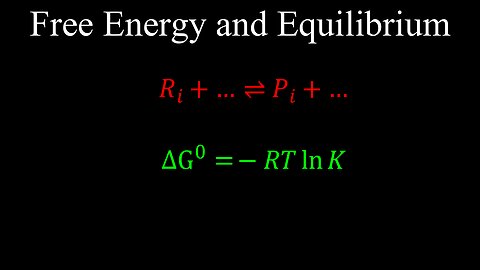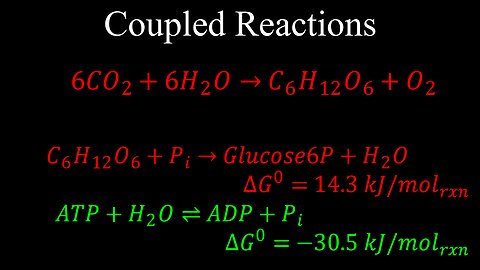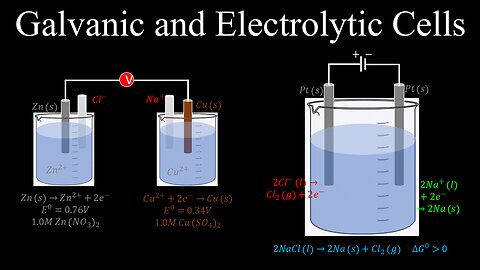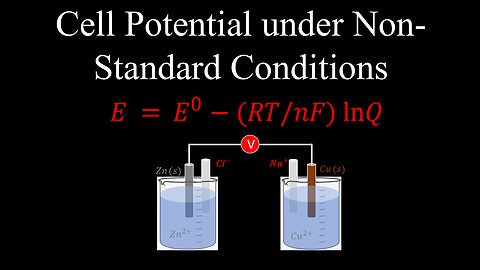Premium Only Content
This video is only available to Rumble Premium subscribers. Subscribe to
enjoy exclusive content and ad-free viewing.
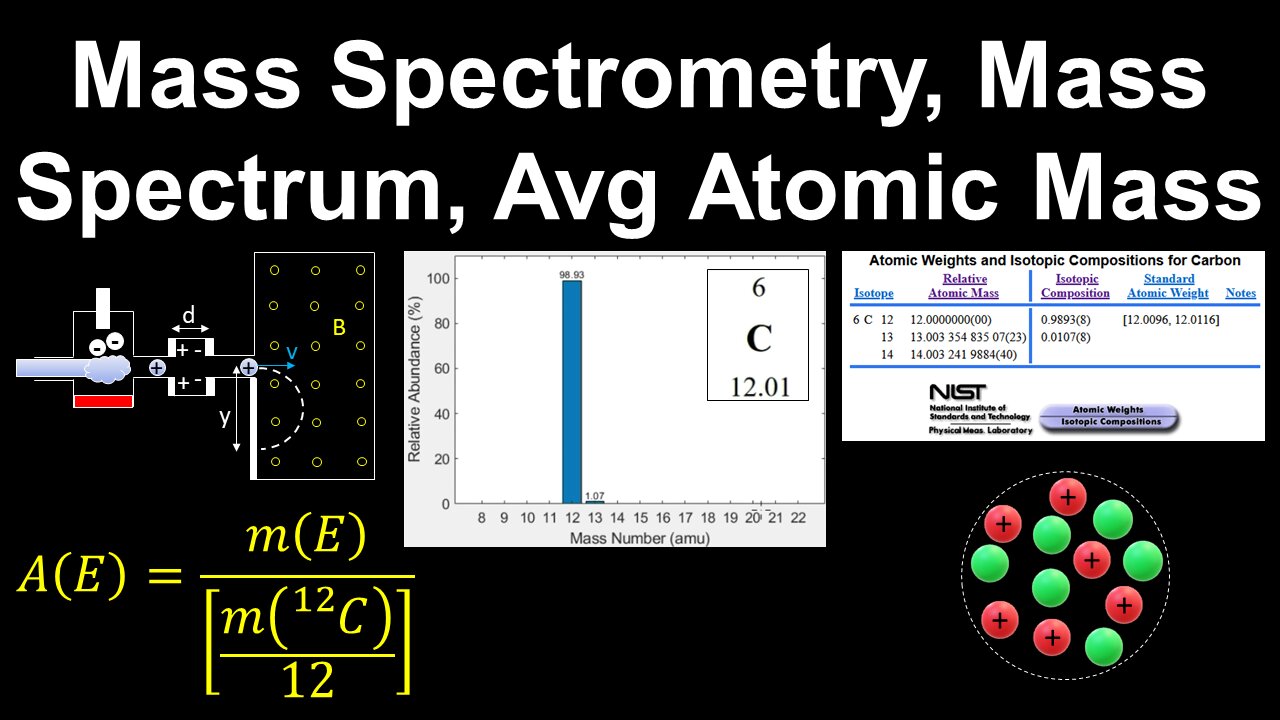
Chemistry (AP, VCE, JEE, NEET, IB)
DrOfEng
- 5 / 163
1
Introduction to Chemistry, Periodic Table - AP Chemistry
DrOfEng
This video provides an introduction to chemistry, and covers some important features of the periodic table.
This video is part of Unit 1 of AP Chemistry on Atomic Structure and Properties.
You can contact me through the comments and community section, or email me at drofeng@gmail.com for questions.
2
Atoms, Isotopes, Atomic Number, Mass Number - AP Chemistry
DrOfEng
This AP Chemistry video explains the notation used in the periodic table, and the structure of atoms and isotopes.
This video is part of Unit 1 of AP Chemistry on Atomic Structure and Properties.
You can contact me through the comments and community section, or email me at drofeng@gmail.com for questions.
3
Moles, Molar Mass, Avogadro's Number - AP Chemistry
DrOfEng
This AP Chemistry video defines the unit of mole using Avogadro's number, which is used to connect the mass of a substance to the number of its particles.
This video is part of Unit 1 of AP Chemistry on Atomic Structure and Properties.
You can contact me through the comments and community section, or email me at drofeng@gmail.com for questions.
4
Moles, Connecting Units - AP Chemistry
DrOfEng
This AP Chemistry video explains how the unit of mole connects other units in Chemistry.
This video is part of Unit 1 of AP Chemistry on Atomic Structure and Properties.
You can contact me through the comments and community section, or email me at drofeng@gmail.com for questions.
Mass Spectrometry, Molar Mass, Average Atomic Mass, Mass Defect - AP Chemistry
DrOfEng
This AP Chemistry video explains mass spectrometry and how it is used to identify the isotopes of an element, interpreting the mass spectrum, relationship between the molar mass and average atomic mass, and the mass defect.
This video is part of Unit 1 of AP Chemistry on Atomic Structure and Properties.
You can contact me through the comments and community section, or email me at drofeng@gmail.com for questions.
6
Mass Spectrometry, Example - AP Chemistry
DrOfEng
This AP Chemistry video covers a worked example on mass spectrometry.
This video is part of Unit 1 of AP Chemistry on Atomic Structure and Properties.
You can contact me through the comments and community section, or email me at drofeng@gmail.com for questions.
7
Pure Substances - AP Chemistry
DrOfEng
This AP Chemistry video defines pure substances using several examples.
This video is part of Unit 1 of AP Chemistry on Atomic Structure and Properties.
You can contact me through the comments and community section, or email me at drofeng@gmail.com for questions.
8
Law of Definite Proportions, Pure Substances - AP Chemistry
DrOfEng
This AP Chemistry video explains the law of definite proportions for pure substances.
This video is part of Unit 1 of AP Chemistry on Atomic Structure and Properties.
You can contact me through the comments and community section, or email me at drofeng@gmail.com for questions.
9
Empirical Formula, Pure Substances - AP Chemistry
DrOfEng
This AP Chemistry video defines the empirical formula for pure substances.
This video is part of Unit 1 of AP Chemistry on Atomic Structure and Properties.
You can contact me through the comments and community section, or email me at drofeng@gmail.com for questions.
10
Pure Substances, Percent Composition, Example - AP Chemistry
DrOfEng
This AP Chemistry video covers a worked example on determining the percentage composition of each element in a pure substance.
This video is part of Unit 1 of AP Chemistry on Atomic Structure and Properties.
You can contact me through the comments and community section, or email me at drofeng@gmail.com for questions.
11
Empirical Formula, Molecular Formula, Examples - AP Chemistry
DrOfEng
This AP Chemistry video covers worked examples on finding the empirical or molecular formula of a compound in a pure substance.
This video is part of Unit 1 of AP Chemistry on Atomic Structure and Properties.
You can contact me through the comments and community section, or email me at drofeng@gmail.com for questions.
12
Composition of Mixtures, Formula Units - AP Chemistry
DrOfEng
This AP Chemistry video explains the composition of mixtures and formula units using several examples.
This video is part of Unit 1 of AP Chemistry on Atomic Structure and Properties.
You can contact me through the comments and community section, or email me at drofeng@gmail.com for questions.
13
Composition of Mixtures, Examples - AP Chemistry
DrOfEng
This AP Chemistry video covers worked examples on the composition of mixtures.
This video is part of Unit 1 of AP Chemistry on Atomic Structure and Properties.
You can contact me through the comments and community section, or email me at drofeng@gmail.com for questions.
14
Coulomb Force, Bohr Model, Atoms - AP Chemistry
DrOfEng
This AP Chemistry video explains Coulomb's law and the forces between charges in an atom using the simplified Bohr model.
This video is part of Unit 1 of AP Chemistry on Atomic Structure and Properties.
You can contact me through the comments and community section, or email me at drofeng@gmail.com for questions.
15
Energy Levels, Shells, Subshells, Orbitals - AP Chemistry
DrOfEng
This AP Chemistry video explains the types of shells, subshells and orbitals present in an atom at different energy levels.
This video is part of Unit 1 of AP Chemistry on Atomic Structure and Properties.
You can contact me through the comments and community section, or email me at drofeng@gmail.com for questions.
16
Shapes of Orbitals - AP Chemistry
DrOfEng
This AP Chemistry video explains the shapes of s and p orbitals, which are obtained from quantum mechanics.
This video is part of Unit 1 of AP Chemistry on Atomic Structure and Properties.
You can contact me through the comments and community section, or email me at drofeng@gmail.com for questions.
17
Electron Configuration, Aufbau, Pauli's Exclusion, Hund's Rule - AP Chemistry
DrOfEng
This AP Chemistry video explains Aufbau's rule, Pauli's exclusion principle and Hund's rule for determining the electron configuration of an atom.
This video is part of Unit 1 of AP Chemistry on Atomic Structure and Properties.
You can contact me through the comments and community section, or email me at drofeng@gmail.com for questions.
18
Electron Configuration, Exceptions to the Aufbau Rule, Chromium - AP Chemistry
DrOfEng
This AP Chemistry video explains how to determine the electron configuration for an atom which is an exception to Aufbau's rule, using Chromium as an example.
This video is part of Unit 1 of AP Chemistry on Atomic Structure and Properties.
You can contact me through the comments and community section, or email me at drofeng@gmail.com for questions.
19
Electron Configuration, Silicon, Iron, Examples - AP Chemistry
DrOfEng
This AP Chemistry video covers worked examples on determining the electron configuration of an atom.
This video is part of Unit 1 of AP Chemistry on Atomic Structure and Properties.
You can contact me through the comments and community section, or email me at drofeng@gmail.com for questions.
20
Valence Electrons, Noble Gas Notation, Ionisation Energy - AP Chemistry
DrOfEng
This AP Chemistry video defines valence electrons, explains how to write the electron configuration of an atom using shorthand (or noble gas) notation, and how to qualitatively estimate the ionisation energy using the energy analog of Coulomb's law.
This video is part of Unit 1 of AP Chemistry on Atomic Structure and Properties.
You can contact me through the comments and community section, or email me at drofeng@gmail.com for questions.
21
Shielding, Effective Nuclear Charge - AP Chemistry
DrOfEng
This AP Chemistry video explains the concepts of electron shielding and effective nuclear charge to determine the ionisation energy of atoms and ions relative to each other.
This video is part of Unit 1 of AP Chemistry on Atomic Structure and Properties.
You can contact me through the comments and community section, or email me at drofeng@gmail.com for questions.
1
comment
22
Photoelectron Spectroscopy - AP Chemistry
DrOfEng
This AP Chemistry video explains the steps of photoelectron spectroscopy, which is an experiment used to determine the electron configuration of an atom.
This video is part of Unit 1 of AP Chemistry on Atomic Structure and Properties.
You can contact me through the comments and community section, or email me at drofeng@gmail.com for questions.
23
Photoelectron Spectrum, Interpretation - AP Chemistry
DrOfEng
This AP Chemistry video explains how to interpret a photoelectron spectrum to determine the electron configuration of an atom.
This video is part of Unit 1 of AP Chemistry on Atomic Structure and Properties.
You can contact me through the comments and community section, or email me at drofeng@gmail.com for questions.
24
Photoelectron Spectrum, Examples - AP Chemistry
DrOfEng
This AP Chemistry video covers worked examples on interpreting a photoelectron spectrum to determine the electron configuration of an atom.
This video is part of Unit 1 of AP Chemistry on Atomic Structure and Properties.
You can contact me through the comments and community section, or email me at drofeng@gmail.com for questions.
25
Photoelectron Spectroscopy, Example - AP Chemistry
DrOfEng
This AP Chemistry video covers a worked example on obtaining the parameters of the electromagnetic radiation source from a photoelectron spectroscopy experiment.
This video is part of Unit 1 of AP Chemistry on Atomic Structure and Properties.
You can contact me through the comments and community section, or email me at drofeng@gmail.com for questions.
26
Periodic Trends, Ionisation Energy - AP Chemistry
DrOfEng
This AP Chemistry video explains the periodic trend in ionisation energy using the periodic table.
This video is part of Unit 1 of AP Chemistry on Atomic Structure and Properties.
You can contact me through the comments and community section, or email me at drofeng@gmail.com for questions.
27
Periodic Trends, Atomic Radius - AP Chemistry
DrOfEng
This AP Chemistry video explains the periodic trend in atomic radius using the periodic table.
This video is part of Unit 1 of AP Chemistry on Atomic Structure and Properties.
You can contact me through the comments and community section, or email me at drofeng@gmail.com for questions.
28
Periodic Trends, Ionic Radius, Cation, Anion - AP Chemistry
DrOfEng
This AP Chemistry video explains the periodic trend in ionic radius using the periodic table, and compares the atomic radii and ionic radii of atoms and ions.
This video is part of Unit 1 of AP Chemistry on Atomic Structure and Properties.
You can contact me through the comments and community section, or email me at drofeng@gmail.com for questions.
29
Periodic Trends, Electron Affinity - AP Chemistry
DrOfEng
This AP Chemistry video explains the periodic trend in electron affinity using the periodic table, which is the energy released when an electron is attached to an atom to form an anion.
This video is part of Unit 1 of AP Chemistry on Atomic Structure and Properties.
You can contact me through the comments and community section, or email me at drofeng@gmail.com for questions.
30
Periodic Table, Trends, Electronegativity - AP Chemistry
DrOfEng
This AP Chemistry video explains the periodic trend in electronegativity using the periodic table, which is the ability of an atom to attract an electron from another atom to form a chemical bond.
This video is part of Unit 1 of AP Chemistry on Atomic Structure and Properties.
You can contact me through the comments and community section, or email me at drofeng@gmail.com for questions.
31
Periodic Table, Trends, Worked Examples - AP Chemistry
DrOfEng
This AP Chemistry video covers worked examples on periodic trends in the periodic table.
This video is part of Unit 1 of AP Chemistry on Atomic Structure and Properties.
You can contact me through the comments and community section, or email me at drofeng@gmail.com for questions.
32
Ionic Compounds - AP Chemistry
DrOfEng
This AP Chemistry video explains how ionic compounds are formed and the number of charges gained or lost based on the groups of the elements in the periodic table.
This video is part of Unit 1 of AP Chemistry on Atomic Structure and Properties.
You can contact me through the comments and community section, or email me at drofeng@gmail.com for questions.
33
Ionic Compounds from Transition Metals, Analogous Compounds - AP Chemistry
DrOfEng
This AP Chemistry video explains how to name different ionic compounds formed from a transition metal, and analogous ionic compounds.
This video is part of Unit 1 of AP Chemistry on Atomic Structure and Properties.
You can contact me through the comments and community section, or email me at drofeng@gmail.com for questions.
34
Chemical Bond Types, Electronegativity Pauling Scale - AP Chemistry
DrOfEng
This AP Chemistry video summarises the types of chemical bonds, being ionic, covalent (polar and non-polar) and metallic.
This video is part of Unit 2 of AP Chemistry on Molecular and Ionic Compound Structure and Properties.
You can contact me through the comments and community section, or email me at drofeng@gmail.com for questions.
35
Covalent Bond Designations, Bond Length - AP Chemistry
DrOfEng
This AP Chemistry video explains the properties of single, double and triple covalent bonds.
This video is part of Unit 2 of AP Chemistry on Molecular and Ionic Compound Structure and Properties.
You can contact me through the comments and community section, or email me at drofeng@gmail.com for questions.
36
Covalent Bonds, Polarity, Dipole Moment - AP Chemistry
DrOfEng
This AP Chemistry video explains the polarity of covalent bonds, dipole moments and how to determine whether a bond is covalent or ionic.
This video is part of Unit 2 of AP Chemistry on Molecular and Ionic Compound Structure and Properties.
You can contact me through the comments and community section, or email me at drofeng@gmail.com for questions.
37
Intramolecular Force, Potential Energy, Covalent Bonds - AP Chemistry
DrOfEng
This AP Chemistry video explains how to interpret the potential energy diagram for a covalent bond, and identify the bond length and bond energy.
This video is part of Unit 2 of AP Chemistry on Molecular and Ionic Compound Structure and Properties.
You can contact me through the comments and community section, or email me at drofeng@gmail.com for questions.
38
Interactions, Cations and Anions, Coulomb's Law - AP Chemistry
DrOfEng
This AP Chemistry video explains the interactions between cations and anions using Couloumb's law.
This video is part of Unit 2 of AP Chemistry on Molecular and Ionic Compound Structure and Properties.
You can contact me through the comments and community section, or email me at drofeng@gmail.com for questions.
1
comment
39
Ionic Solids, Structure, Properties - AP Chemistry
DrOfEng
This AP Chemistry video explains the structure and properties of ionic solids.
This video is part of Unit 2 of AP Chemistry on Molecular and Ionic Compound Structure and Properties.
You can contact me through the comments and community section, or email me at drofeng@gmail.com for questions.
40
Structure of Metals, Sea of Electrons Model - AP Chemistry
DrOfEng
This AP Chemistry video explains the structure and properties of metals, and metallic bonds using the sea of electrons model.
This video is part of Unit 2 of AP Chemistry on Molecular and Ionic Compound Structure and Properties.
You can contact me through the comments and community section, or email me at drofeng@gmail.com for questions.
41
Interstitial Alloys, Metals - AP Chemistry
DrOfEng
This AP Chemistry video explains the structure of interstitial alloys using steel as a typical example.
This video is part of Unit 2 of AP Chemistry on Molecular and Ionic Compound Structure and Properties.
You can contact me through the comments and community section, or email me at drofeng@gmail.com for questions.
42
Substitutional Alloys, Metals - AP Chemistry
DrOfEng
This AP Chemistry video explains the structure of substitutional alloys using brass as a typical example.
This video is part of Unit 2 of AP Chemistry on Molecular and Ionic Compound Structure and Properties.
You can contact me through the comments and community section, or email me at drofeng@gmail.com for questions.
43
Lewis Diagrams - AP Chemistry
DrOfEng
This AP Chemistry video explains how to draw a Lewis diagram for a molecule or polyatomic ion using a set of rules.
This video is part of Unit 2 of AP Chemistry on Molecular and Ionic Compound Structure and Properties.
You can contact me through the comments and community section, or email me at drofeng@gmail.com for questions.
44
Lewis Diagrams, Resonance Structures, Bond Order - AP Chemistry
DrOfEng
This AP Chemistry video explains how to draw Lewis diagrams of the resonance structures of a molecule or polyatomic ion and determine the bond order.
This video is part of Unit 2 of AP Chemistry on Molecular and Ionic Compound Structure and Properties.
You can contact me through the comments and community section, or email me at drofeng@gmail.com for questions.
45
Lewis Diagrams, Formal Charge - AP Chemistry
DrOfEng
This AP Chemistry video explains how the formal charge can be calculated and used to determine the most likely correct Lewis diagram of a molecule or polyatomic ion.
This video is part of Unit 2 of AP Chemistry on Molecular and Ionic Compound Structure and Properties.
You can contact me through the comments and community section, or email me at drofeng@gmail.com for questions.
46
Lewis Diagrams, Reduced Octet, Formal Charge - AP Chemistry
DrOfEng
This AP Chemistry video explains how to draw the Lewis diagram for a molecule or polyatomic ion where the central atom has a reduced octet.
This video is part of Unit 2 of AP Chemistry on Molecular and Ionic Compound Structure and Properties.
You can contact me through the comments and community section, or email me at drofeng@gmail.com for questions.
47
Lewis Diagrams, Expanded Octet , Formal Charge - AP Chemistry
DrOfEng
This AP Chemistry video explains how to draw the Lewis diagram for a molecule or polyatomic ion where the central atom has an expanded octet.
This video is part of Unit 2 of AP Chemistry on Molecular and Ionic Compound Structure and Properties.
You can contact me through the comments and community section, or email me at drofeng@gmail.com for questions.
48
Lewis Diagrams, Free Radical, Formal Charge - AP Chemistry
DrOfEng
This AP Chemistry video explains how to draw the Lewis diagram for a free radical (has unpaired electrons).
This video is part of Unit 2 of AP Chemistry on Molecular and Ionic Compound Structure and Properties.
You can contact me through the comments and community section, or email me at drofeng@gmail.com for questions.
1
comment
49
Lewis Diagrams, Resonance, Formal Charge, Worked Examples, XeF6, CH3COO-, CH3COOH - AP Chemistry
DrOfEng
This AP Chemistry video covers worked examples on Lewis diagrams.
This video is part of Unit 2 of AP Chemistry on Molecular and Ionic Compound Structure and Properties.
You can contact me through the comments and community section, or email me at drofeng@gmail.com for questions.
50
sp Hybridisation, VSEPR, BeH2 - AP Chemistry
DrOfEng
This AP Chemistry video demonstrates how to draw the geometry of a molecule using bond hybridisation and VSEPR, where the central atom is sp hybridised.
This video is part of Unit 2 of AP Chemistry on Molecular and Ionic Compound Structure and Properties.
You can contact me through the comments and community section, or email me at drofeng@gmail.com for questions.
51
sp2 Hybridisation, Trigonal Planar, VSEPR - AP Chemistry
DrOfEng
This AP Chemistry video demonstrates how to draw the geometry of a molecule using bond hybridisation and VSEPR, where the central atom is sp2 hybridised with 3 sigma bonds.
This video is part of Unit 2 of AP Chemistry on Molecular and Ionic Compound Structure and Properties.
You can contact me through the comments and community section, or email me at drofeng@gmail.com for questions.
52
sp2 Hybridisation, Bent, VSEPR - AP Chemistry
DrOfEng
This AP Chemistry video demonstrates how to draw the geometry of a molecule using bond hybridisation and VSEPR, where the central atom is sp2 hybridised with 2 sigma bonds and a lone pair of electrons.
This video is part of Unit 2 of AP Chemistry on Molecular and Ionic Compound Structure and Properties.
You can contact me through the comments and community section, or email me at drofeng@gmail.com for questions.
53
sp3 Hybridisation, Tetrahedral, VSEPR - AP Chemistry
DrOfEng
This AP Chemistry video demonstrates how to draw the geometry of a molecule using bond hybridisation and VSEPR, where the central atom is sp3 hybridised with 4 sigma bonds.
This video is part of Unit 2 of AP Chemistry on Molecular and Ionic Compound Structure and Properties.
You can contact me through the comments and community section, or email me at drofeng@gmail.com for questions.
54
sp3 Hybridisation, Trigonal Pyramidal, VSEPR - AP Chemistry
DrOfEng
This AP Chemistry video demonstrates how to draw the geometry of a molecule using bond hybridisation and VSEPR, where the central atom is sp3 hybridised with 3 sigma bonds and a lone pair of electrons.
This video is part of Unit 2 of AP Chemistry on Molecular and Ionic Compound Structure and Properties.
You can contact me through the comments and community section, or email me at drofeng@gmail.com for questions.
55
sp3 Hybridisation, Bent, VSEPR - AP Chemistry
DrOfEng
This AP Chemistry video demonstrates how to draw the geometry of a molecule using bond hybridisation and VSEPR, where the central atom is sp3 hybridised with 2 sigma bonds and two lone pairs of electrons.
This video is part of Unit 2 of AP Chemistry on Molecular and Ionic Compound Structure and Properties.
You can contact me through the comments and community section, or email me at drofeng@gmail.com for questions.
56
Steric Number, VSEPR, Molecular Geometry - AP Chemistry
DrOfEng
This AP Chemistry video demonstrates how to quickly determine the geometry of a molecule or polyatomic ion using the steric number.
This video is part of Unit 2 of AP Chemistry on Molecular and Ionic Compound Structure and Properties.
You can contact me through the comments and community section, or email me at drofeng@gmail.com for questions.
57
Orbital Overlap Diagrams, Bond Formation - AP Chemistry
DrOfEng
This AP Chemistry video demonstrates how to draw orbital overlap diagrams, where the overlap between electron orbitals results in sigma and pi bonds.
This video is part of Unit 2 of AP Chemistry on Molecular and Ionic Compound Structure and Properties.
You can contact me through the comments and community section, or email me at drofeng@gmail.com for questions.
58
Structural Isomers, pi Bonds - AP Chemistry
DrOfEng
This AP Chemistry video covers structural isomers with pi bonds and explains how to determine the geometry of a large molecule.
This video is part of Unit 2 of AP Chemistry on Molecular and Ionic Compound Structure and Properties.
You can contact me through the comments and community section, or email me at drofeng@gmail.com for questions.
59
Bond Hybridisation, Molecular Geometry, Example - AP Chemistry
DrOfEng
This AP Chemistry video covers a worked example on bond hybridisation and molecular geometry.
This video is part of Unit 2 of AP Chemistry on Molecular and Ionic Compound Structure and Properties.
You can contact me through the comments and community section, or email me at drofeng@gmail.com for questions.
60
Orbital Overlap Diagram, Bonds, Example - AP Chemistry
DrOfEng
This AP Chemistry video covers a worked example on orbital overlap diagrams.
This video is part of Unit 2 of AP Chemistry on Molecular and Ionic Compound Structure and Properties.
You can contact me through the comments and community section, or email me at drofeng@gmail.com for questions.
61
Polarity of Molecules - AP Chemistry
DrOfEng
This AP Chemistry video explains how to determine the polarity of a molecular using the polarity of the covalent bonds and symmetry in the molecule's geometry.
This video is part of Unit 3 of AP Chemistry on Intermolecular Forces and Properties.
You can contact me through the comments and community section, or email me at drofeng@gmail.com for questions.
62
Polarity of Molecules, Example - Chemistry
DrOfEng
This video covers a worked example on the polarity of molecules (e.g. pcl5, ch4, of2) which can be determined from molecular geometry or lewis diagram and bonds. You will be able to understand how do you tell if a molecule is polar or nonpolar, what is the definition or meaning of polarity, and which molecule is more polar.
63
Intermolecular Forces, van der Waals forces, Introduction - AP Chemistry
DrOfEng
This AP Chemistry video provides an introduction to intermolecular forces.
This video is part of Unit 3 of AP Chemistry on Intermolecular Forces and Properties.
You can contact me through the comments and community section, or email me at drofeng@gmail.com for questions.
1
comment
64
London Dispersion Forces, Temporary Fluctuating Dipoles - AP Chemistry
DrOfEng
This AP Chemistry video explains London Dispersion Forces, which are weak intermolecular interactions that are most prominent in large molecules, and can also occur between non-polar molecules.
This video is part of Unit 3 of AP Chemistry on Intermolecular Forces and Properties.
You can contact me through the comments and community section, or email me at drofeng@gmail.com for questions.
65
Dipole-Induced Dipole Interactions - AP Chemistry
DrOfEng
This AP Chemistry video explains dipole-induced dipole interactions which are forces between polar and non-polar molecules.
This video is part of Unit 3 of AP Chemistry on Intermolecular Forces and Properties.
You can contact me through the comments and community section, or email me at drofeng@gmail.com for questions.
1
comment
66
Dipole-Dipole Interactions, Hydrogen Bonds - AP Chemistry
DrOfEng
This AP Chemistry video explains dipole-dipole interactions which are forces between polar molecules, and hydrogen bonding, which is a strong type of dipole-dipole interaction between polar molecules.
This video is part of Unit 3 of AP Chemistry on Intermolecular Forces and Properties.
You can contact me through the comments and community section, or email me at drofeng@gmail.com for questions.
1
comment
67
Ion-Dipole Interactions - AP Chemistry
DrOfEng
This AP Chemistry video explains ion-dipole interactions, which is a strong interaction between an ion and polar molecule.
This video is part of Unit 3 of AP Chemistry on Intermolecular Forces and Properties.
You can contact me through the comments and community section, or email me at drofeng@gmail.com for questions.
68
Large Biomolecules, Non-Covalent Interactions - AP Chemistry
DrOfEng
This AP Chemistry video explains non-covalent interactions in large biomolecules, which can occur within the same biomolecule and with other molecules.
This video is part of Unit 3 of AP Chemistry on Intermolecular Forces and Properties.
You can contact me through the comments and community section, or email me at drofeng@gmail.com for questions.
69
Vapour Pressure, Boiling Point, Melting Point - AP Chemistry
DrOfEng
This AP Chemistry video explains the main properties of solids and liquids (vapour pressure, boiling point and melting point) and how they are related to the intermolecular forces.
This video is part of Unit 3 of AP Chemistry on Intermolecular Forces and Properties.
You can contact me through the comments and community section, or email me at drofeng@gmail.com for questions.
1
comment
70
Intermolecular Forces, Vapour Pressure, Boiling Point, Examples - AP Chemistry
DrOfEng
This AP Chemistry video covers a worked example on intermolecular forces, vapour pressure and boiling point.
This video is part of Unit 3 of AP Chemistry on Intermolecular Forces and Properties.
You can contact me through the comments and community section, or email me at drofeng@gmail.com for questions.
1
comment
71
Particulate-Level Representations, Chemical Species, Interactions - AP Chemistry
DrOfEng
This AP Chemistry video explains how particulate-level representations can be used to visualise different chemical species and the interactions between them, which leads to establishing their macroscopic properties (e.g. vapour pressure, boiling point, melting point).
This video is part of Unit 3 of AP Chemistry on Intermolecular Forces and Properties.
You can contact me through the comments and community section, or email me at drofeng@gmail.com for questions.
1
comment
72
Ionic Solids - Chemistry
DrOfEng
This chemistry video covers a tutorial on ionic solids. It explains how the lattice structure of ionic solids and the Coulomb interactions between the ions are used to describe their properties including low vapour pressure, high boiling and melting points, brittleness and poor conductivity in the solid phase. The cations and anions in ionic solids are arranged to minimise repulsion between opposite charges. In the liquid state, the ions are mobile and conduct electricity.
73
Covalent Network Solids - Chemistry
DrOfEng
This chemistry video covers a tutorial on covalent network solids. It explains how the chemical structures of covalent network solids and their restricted bond angles are used to describe their properties including rigidity, hardness, brittleness and poor conductivity. Several examples of covalent network solids are covered including diamond, graphite and silicon carbide, which are arranged in a tetrahedral or multi-layered configuration.
74
Molecular Solids - Chemistry
DrOfEng
This chemistry video covers a tutorial on molecular solids. It explains how the intermolecular interactions, including dipoles and london dispersion forces, and the restricted movement of valence electrons are used to describe the properties of molecular solids, including low melting and sublimation points, and poor conductivity. Several examples of molecular solids are covered including dry ice and ice.
75
Metallic Solids - Chemistry
DrOfEng
This chemistry video covers a tutorial on metallic solids. It explains how the lattice structure, which can be represented using a sea of electrons model, and includes delocalised valence electrons, can be used to describe the properties of metallic solids, including malleability, ductility and conductivity of both electricity and heat. An example of an interstitial alloy is provided, being steel, to show how the addition of carbon at the interstitial sites can increase the rigidity while decreasing the ductility of the alloy.
76
Large Biomolecules and Polymers - Chemistry
DrOfEng
This chemistry video covers a tutorial on large biomolecules and polymers. It explains how the structure of a large biomolecule leads to stable forms, such as the ring formation of glucose, which is more stable in water than dry glucose. Polymers are also covered, which are composed of a chain of repeating units called monomers.
1
comment
77
Crystalline Vs Amorphous Solids - AP Chemistry
DrOfEng
This chemistry video covers a tutorial on crystalline and amorphous solids. It explains the difference between the structures of crystalline and amorphous solids and provides examples. For example, metals and ceramics have a densely packed crystalline structure whereas glass has an amorphous structure.
78
Liquid Phase, Molar Volume - Chemistry
DrOfEng
This chemistry video covers a tutorial on the liquid phase. It explains how the nature and strength of the intermolecular forces and temperature influence the arrangement and movement of the particles. Also explained is the reason as to why the molar volume of ice is slightly lower than that of water.
79
Gas Phase - Chemistry
DrOfEng
This chemistry video covers a tutorial on the gas phase. It explains how the frequencies of collisions and average spacing between the gas particles are influenced by pressure, volume and temperature. The gas does not have a definite volume due to the weak van der Waals forces between the molecules and the random motion of the gas particles.
1
comment
80
Ideal Gas Law - Chemistry
DrOfEng
This chemistry video covers a tutorial on the ideal gas law. It explains the relationship between the macroscopic properties of an ideal gas, namely pressure, volume and temperature. The ratio of the pressure, volume and temperature can be constant under certain conditions.
81
Dalton's Law, Ideal Gas Mixture - Chemistry
DrOfEng
This chemistry video covers a tutorial on the Dalton's law for a mixture of ideal gases. Dalton's law states that the total pressure of the mixture is equal to the sum of the partial pressures of the gas components, which are independent of each other.
82
Gay-Lussac's Law, Ideal Gas, Constant Volume - Chemistry
DrOfEng
This chemistry video covers a tutorial on Gay-Lussac's law for an ideal gas. Gay-Lussac's law is a special case of the ideal gas law where the volume of the gas is held constant. In this case, the pressure is proportional to the temperature of the gas.
83
Boyle's Law, Ideal Gas, Constant Temperature - Chemistry
DrOfEng
This chemistry video covers a tutorial on Boyle's law for an ideal gas. Boyle's law is a special case of the ideal gas law where the temperature of the gas is held constant. In this case, the pressure is inversely proportional to the volume of the gas.
84
Charles' Law, Ideal Gas, Constant Pressure - Chemistry
DrOfEng
This chemistry video covers a tutorial on Charles' law for an ideal gas. Charles' law is a special case of the ideal gas law where the pressure of the gas is held constant. In this case, the volume is inversely proportional to the temperature of the gas.
1
comment
85
Ideal Gas Law, Dalton's Law, Examples - Chemistry
DrOfEng
This chemistry video covers a tutorial on the ideal gas law and Dalton's law. Worked examples are covered to reinforce your understanding.
86
Kinetic Molecular Theory - Chemistry
DrOfEng
This chemistry video covers a tutorial on the kinetic molecular theory of ideal gases and the key assumptions, which is what the ideal gas law is based on.
1
comment
87
Maxwell-Boltzmann Distribution - Chemistry
DrOfEng
This chemistry video covers a tutorial on the Maxwell-Boltzmann distribution of velocities for an ideal gas or a mixture of ideal gases. The distribution of velocities for two cases are given, the same ideal gas at different temperatures and a mixture of ideal gases at the same temperature.
88
Maxwell-Boltzmann Distribution, Kinetic Molecular Theory, Example - Chemistry
DrOfEng
This chemistry video covers a tutorial on kinetic molecular theory and the Maxwell-Boltzmann distribution of velocities for an ideal gas or a mixture of ideal gases. The distribution of velocities for two cases are given, the same ideal gas at different temperatures and a mixture of ideal gases at the same temperature. A worked example is covered to reinforce your understanding.
89
Deviation from Ideal Gas - Chemistry
DrOfEng
This chemistry video covers a tutorial on the deviation from ideal gas behaviour. The two main conditions where a gas deviates from ideal behaviour are when the volume of the gas particle is not negligible compared to the volume of the gas and when intermolecular forces become significant near condensation conditions.
1
comment
90
Deviation from Ideal Gas Law, Examples - Chemistry
DrOfEng
This chemistry video covers a tutorial on the deviation from ideal gas behaviour. The two main conditions where a gas deviates from ideal behaviour are when the volume of the gas particle is not negligible compared to the volume of the gas and when intermolecular forces become significant near condensation conditions. Examples are provided to reinforce your understanding.
1
comment
91
Homogeneous Vs Heterogeneous Mixtures, Solutions - Chemistry
DrOfEng
This chemistry video covers a tutorial on homogeneous and heterogeneous mixtures. Homogeneous mixtures are also referred to as solutions. These types of mixtures can be multi-phase, and solids, liquids and gases.
92
Molarity, Solutions - Chemistry
DrOfEng
This chemistry video covers a tutorial on the molarity or the molar concentration of solutions, which is commonly used in a laboratory. A solute dissolves in a solvent.
93
Molarity, Dilution, Solutions, Examples - Chemistry
DrOfEng
This chemistry video covers a tutorial on the molarity or the molar concentration of solutions, which is commonly used in a laboratory. Examples on molarity and dilution are provided for practice.
94
Particulate Models, Solutions - Chemistry
DrOfEng
This chemistry video covers a tutorial on particulate models which are used to represent solutions.
0:00 Intro to particulate representations of solutions
0:10 Example, sodium chloride
1:04 Example, magnesium chloride
1:54 Example, Sodium sulfate
1
comment
95
Chromatography, Distillation, Separating Solutions and Mixtures - Chemistry
DrOfEng
This chemistry video covers a tutorial on the methods used for separating solutions and mixtures. These include paper chromatography, thin-layer chromatography, column chromatography and distillation.
0:00 Introduction to separating solutions and mixtures, paper chromatography
2:22 Thin-layer chromatography
4:41 Column chromatography
6:00 Simple Vs fractional distillation
8:23 Worked example on chromatography
1
comment
96
Solubility - Chemistry
DrOfEng
This chemistry video covers a tutorial on solubility. Polar solutes dissolve in polar solvents, and non-polar solutes dissolve in non-polar solvents.
97
Spectroscopy, Electromagnetic Spectrum - Chemistry
DrOfEng
This chemistry video covers a tutorial on spectroscopy and the electromagnetic spectrum. It explains how energy from different parts of the electromagnetic spectrum results in electronic transitions in molecules.
98
Photoelectric Effect - AP Chemistry
DrOfEng
This chemistry video covers a tutorial on the photoelectric effect.
1
comment
99
Spectrophotometry, Beer Lambert Law - Chemistry
DrOfEng
This chemistry video covers a tutorial on the spectrophotometry experiment and the Beer-Lambert law.
0:00 Spectrophotometry experiment
1:54 Beer-Lambert law
3:32 Worked example on spectrophotometry and the Beer-Lambert law
1
comment
100
Physical Vs Chemical Changes, Intro to Reactions - Chemistry
DrOfEng
This chemistry video covers a tutorial that provides an introduction to reactions and explains the difference between physical and chemical changes.
101
4.2a Balancing Chemical Equations, Net Ionic Equations - AP Chemistry
DrOfEng
This chemistry video covers a tutorial on balancing chemical equations and net ionic equations.
0:00 Intro the balancing chemical equations with example
1:13 Worked examples on balancing chemical equations
2:42 Representing reactions using balanced molecular, complete ionic and net ionic equations
2
comments
102
Particulate Models, Reactions - AP Chemistry
DrOfEng
This chemistry video covers a tutorial on how to represent reactions using particulate models.
103
Physical and Chemical Changes - Chemistry
DrOfEng
This chemistry video covers a tutorial on how to determine if a process is a physical or chemical change or both.
1
comment
104
Stoichiometry, Limiting Reactant, Molarity, Percent Yield - Chemistry
DrOfEng
This chemistry video covers a tutorial on how to solve stoichiometry problems involving the ideal gas law, molarity, limiting reactant and percent yield.
0:00 Intro to stoichiometry
1:38 Worked example on finding the number of moles of a reactant
3:03 Worked example on finding the empirical formula
5:13 Worked example on finding the molarity of a solution
6:44 Worked example on finding the limiting reactant
8:41 Worked example on finding the percent yield
3
comments
105
Titration, Introduction - Chemistry
DrOfEng
This chemistry video covers a tutorial that provides an introduction to titration using an acid-base titration as an example.
1
comment
106
Types of Chemical Reactions, Oxidation States, Solubility Rules - Chemistry
DrOfEng
This chemistry video covers a tutorial on the different types of chemical reactions, oxidation states, solubility rules and naming polyatomic ions.
0:00 Types of chemical reactions
2:12 Oxidation states
4:34 Solubility rules
5:57 Naming polyatomic ions
107
Intro to Acid-Base Reactions, Bronsted-Lowry - Chemistry
DrOfEng
This chemistry video covers a tutorial that provides an introduction to acid-base reactions using the Bronsted-Lowry definition.
1
comment
108
Balancing Redox Reactions - Chemistry
DrOfEng
This chemistry video covers a tutorial on balancing redox reactions, including in an acidic or basic solution.
0:00 Balancing redox reaction
2:20 Balancing redox reaction in an acidic solution
4:40 Balancing redox reaction in a basic solution
1
comment
109
Reaction Rate, Influencing Factors - Chemistry
DrOfEng
This chemistry video covers a tutorial on the reaction rate and factors influencing it, including the concentration of reactants, temperature and catalysts.
0:00 Reaction rate
1:16 Factors influencing the reaction rate
2:58 Worked example on reaction rate
2
comments
110
Rate Law, Experimental Data - Chemistry
DrOfEng
This chemistry video covers a tutorial on the rate law for a reaction and how to determine the rate law using experimental data.
0:00 Intro to the rate law for a reaction
0:53 Determine the rate law using experimental data
2:58 Worked example on the rate law
1
comment
111
Concentration Vs Time, Half life, Radioactive Decay - Chemistry
DrOfEng
This chemistry video covers a tutorial on the relationship between concentration and time for zeroth, first and second order rate laws. Half life and radioactive decay are also explained using the first order rate law.
0:00 Concentration Vs time, zeroth order reaction
1:36 Concentration Vs time, first order rate law
3:06 Concentration Vs time, second order rate law
4:16 Half life, first order rate law
6:06 Radioactive decay
8:01 Worked example on reaction order and half life
112
Elementary Reactions, Unimolecular, Bimolecular, Termolecular - Chemistry
DrOfEng
This chemistry video covers a tutorial on unimolecular, bimolecular and termolecular elementary reactions and their rate laws.
113
Collision Model, Activation Energy, Example - Chemistry
DrOfEng
This video explains the collision model or theory of reaction rates, including what the collision particle theory is, and the Maxwell-Boltzmann distribution curve. The Arrhenius equation is deferred to another tutorial. The collision model determines if a reaction is likely to occur. The Maxwell-Boltzmann distribution is used to visualise the number of particles at different temperatures that are likely to overcome the activation energy required to initiate the reaction.
1
comment
114
Reaction Energy Profile, Arrhenius Equation - Chemistry
DrOfEng
This video explains the Arrhenius equation or law and the basic theory behind it and what it states.
The reaction energy profile and the Arrhenius equation are used to show the relationship between the activation energy and temperature in the rate constant. The units can be obtained from the rate law.
0:00 Reaction energy profile
2:04 Arrhenius equation
1
comment
115
Intro to Reaction Mechanisms, Intermediates, Example - Chemistry
DrOfEng
This video covers provides an introduction to what is meant by reaction mechanisms, including the definition and examples of intermediates. You will understand the difference between an intermediate and catalyst in a later tutorial.
116
Reaction Mechanism and Rate Law - Chemistry
DrOfEng
This video explains how to determine the rate law from a reaction mechanism, which is a set of elementary chemical equations. Three types of elementary reactions are unimolecular, bimolecular and termolecular.
1
comment
117
Steady-State Vs Pre-Equilibrium Approximation, Rate Law, Kinetics - Chemistry
DrOfEng
This video explains the steady state vs pre-equilibrium approximation, including the approach and assumption behind each method, what is meant by them, rule, equation, rate law and when to use them, and practice problem questions and answers.
0:00 Steady-state approximation
2:14 Pre-equilibrium approximation
118
Multi-Step Reaction Mechanism, Energy Profile, Kinetics - Chemistry
DrOfEng
This video explains a multi-step reaction mechanism using an example, including the energy diagram or profile or graph, how do you know if it is multi-step (multiple) and exothermic or endothermic, and the difference to a single-step reaction.
119
Catalysts, Enzyme Catalysis, Acid-Base Catalysis, Surface - Chemistry
DrOfEng
This video explains the meaning and definition of a catalyst using simple examples, what is meant by catalysis, including in the human body, and catalytic converter of a car.
0:00 Catalysts, energy profile
2:08 Enzyme catalysis
4:03 Acid-base catalysis
6:37 Surface catalysis
2
comments
120
Rate Law, Catalysts, Intermediates, Kinetics, Example - Chemistry
DrOfEng
Example questions (e.g. A,B, -- C, 2B -- C, between easy and hard) on the rate law equation, formula or expression, units of the rate constant, catalysts in simple words, and chemical intermediates. You will understand or explain what is meant by the order of reaction (e.g. first order). Different types of catalysts and example of a catalytic converter is covered in another tutorial.
121
Exothermic and Endothermic Processes, Formation of Solution, Thermodynamics - Chemistry
DrOfEng
This video explains the meaning of endothermic vs exothermic processes using an example of a soluble salt comprising two components, including solute solvent interactions that occur under a physical or chemical change.
0:00 Exothermic and endothermic processes
2:32 Formation of solution
122
Energy Diagrams, Multi-Step Reaction, Endothermic, Exothermic - Chemistry
DrOfEng
The video explains how you draw and interpret the potential energy diagram or profile for a multi step exothermic or endothermic reaction without a catalyst. Enthalpy and activation energy are also labelled to explain how the graph will look and what it represents using an example.
2
comments
123
Heat Transfer, Thermal Equilibrium, Thermodynamics - Chemistry
DrOfEng
Basic introduction to meaning of heat transfer mechanisms in simple terms using an example, with a focus on what occurs during conduction. Heat or thermal energy can be transferred by other processes like convection, radiation or phase change. Thermal equilibrium is when the two conducting bodies are at the same temperature. The heat transfer equation or formula is deferred to another video.
1
comment
124
Heat Capacity, First Law of Thermodynamics, Enthalpy, State Variables, Calorimetry - Chemistry
DrOfEng
Basic introduction into the first law of thermodynamics, an example that highlights its significance, its application in chemistry, basic equation/formula, why it is used, what it deals with. Change in enthalpy or heat content is explained in simple terms, with a basic definition and symbol. The concept of calorimetry, how heat is measured in a calorimeter, basic experiment and analysis using heat capacity and specific heat and what is meant by it.
0:00 Heat capacity
3:27 First law of thermodynamics
5:29 Enthalpy, state variables
7:40 Constant pressure calorimetry
10:03 Worked example
125
Energy of Phase Changes, Enthalpy of Vaporization, Heating Curve, Example - Chemistry
DrOfEng
Heating curve of water (including ice) drawn on diagram to explain energy of phase change, with enthalpy of melting fusion, vaporization, condensation, freezing labelled and defined on the graph. 5 stages explained, including slope, boiling temperature of water.
0:00 Heating curve, energy of phase changes
3:07 Worked example
126
Enthalpy of Reaction, Examples - Chemistry
DrOfEng
This video explains what is meant by enthalpy of reaction, including formula, units and how to find it. Examples are covered on calculations of enthalpy change.
0:00 Intro to enthalpy of reaction
2:37 Worked examples
127
Bond Enthalpy, Enthalpies, Heat of Condensation, Examples - Chemistry
DrOfEng
This video explains the bond enthalpy definition and formula and what is meant by it, how to do calculations of the enthalpy of reaction using some values (e.g. for co or co2), and example questions on how to calculate it.
0:00 Intro to bond enthalpy
3:07 Worked example
128
Enthalpy of Formation, Example - Chemistry
DrOfEng
This video explains the meaning of enthalpy of formation equation vs enthalpy of reaction, including tables (e.g. water (h2o), methane, methanol). Positive means that the formation of the compound is endothermic.
0:00 Enthalpy of formation equation
2:15 Worked example
129
Hess's Law, Enthalpy - Chemistry
DrOfEng
This video explains Hess's law, including the definition or what does it state, formula, equation, and example questions involving constant heat summation.
0:00 Hess's law
1:53 Example
2
comments
130
Intro to Equilibrium, Graphs of Concentration and Rate Vs Time - Chemistry
DrOfEng
This video explains the meaning and what is equilibrium in chemistry. The formula, constant and rule are deferred to another tutorial.
0:00 Intro to equilibrium
2:04 Graphs
131
Reversible Reactions, Equilibrium, Direction, Example - Chemistry
DrOfEng
This video explains what is meant by a reversible reaction, including symbol, meaning, how do you know, and difference to an irreversible reaction.
1
comment
132
Equilibrium Constant, Reaction Quotient, Law of Mass Action - Chemistry
DrOfEng
This video explains the equilibrium constant, including definition, formula, expression in terms of concentration and partial pressure, worked example and practice question. You will understand what is meant by it and what the kc value tells you.
0:00 Reaction quotient and equilibrium constant
2:34 Deriving the equilibrium constant, law of mass action
4:35 Worked example
1
comment
133
Calculating the Equilibrium Constant, Intro to ICE Tables - Chemistry
DrOfEng
This video explains how to use an ice table to calculate the equilibrium constant (Kc or Kp) for a reaction, including practice example problem questions with answers, what they are used for, what the C stands for in ICE and when to use them.
0:00 Calculating the equilibrium constant, intro to ICE tables
2:47 Worked example
1
comment
134
Magnitude of the Equilibrium Constant, Examples - Chemistry
DrOfEng
This video explains the magnitude of the equilibrium constant, including the formula, and what a large or high Kc means.
135
Properties of the Equilibrium Constant, Example - Chemistry
DrOfEng
This video explains how to calculate the equilibrium constant using known constants from other reversible reactions, including expression for when the reaction is reversed or KEQ for a backward reaction, and questions.
0:00 Properties of K
2:45 Worked example
1
comment
136
Calculating Equilibrium Concentrations - Chemistry
DrOfEng
This video explains how to calculate the equilibrium concentration of reactants and products given kc or keq using ICE tables, including units and practice problem. You will understand how to find it and the difference between equilibrium constant and equilibrium concentration.
0:00 Calculating equilibrium concentrations
1:49 Example
137
Particulate Representations of Equilibrium - Chemistry
DrOfEng
This video explains how to interpret particle diagrams to tell if a reaction is at equilibrium. The particulate view can involve charged particles, molecules and so on. They mean to visualise the concentrations of reactants and products at a particular time during the reaction.
138
Intro to Le Chatelier's Principle, Concentration, Pressure, Temperature, Dilution - Chemistry
DrOfEng
This video explains Le Chatelier's principle of shifting equilibrium in terms of the effect of concentration, pressure, temperature and dilution, including what it is in simple words, and a worked example on how to answer practice problems.
0:00 Effect of concentration
1:28 Effect of temperature on reaction shift and equilibrium constant
3:46 Effect of pressure due to volume or inert gas
6:17 Effect of dilution
7:20 Worked Example
1
comment
139
Reaction Quotient and Le Chatelier's Principle, Equilibrium, Example - Chemistry
DrOfEng
This video explains the meaning of reaction quotient vs equilibrium constant, including definition, what happens if Q is bigger or less than K, and the difference between Q and K. You will understand how different stresses like concentration, temperature and catalysts affect the concentrations of reactants and products, the the rate of the forward and backward reaction.
0:00 Reaction quotient, effect of concentration
2:22 Reaction quotient, effect of temperature
4:18 Worked example
140
Solubility Equilibria, Product (Ksp) and Rules, Examples - Chemistry
DrOfEng
This video explains solubility equilibria, including equilibrium equations for salts and sparingly soluble salts, definition, practice problems, what is q (reaction quotient), molar and relative solubility, and common solubility equilibria of carbonates and other ionic compounds.
0:00 Intro to solubility equilibria, solubility product
1:41 Calculating the solubility of a substance
3:37 Relative solubility
5:36 Relating solubility rules to solubility product (Ksp)
6:41 Worked examples
1
comment
141
Common Ion Effect - Chemistry
DrOfEng
This video explains what is meant by the common ion effect, including how does it affect solubility using Le Chatelier's principle and the equilibrium reaction, and example calculations.
1
comment
142
pH and Solubility - Chemistry
DrOfEng
This video explains how pH affects solubility, including an example on how the addition of an acidic solution affects an equilibrium reaction using Le Chatelier's principle.
143
Free Energy of Dissolution, Enthalpy, Entropy, Example - AP Chemistry
DrOfEng
This video explains how the standard enthalpy and entropy (which are related by the Gibbs free energy) change during the steps of dissolution of an ionic compound (e.g. sodium chloride), which includes the breaking of solute bonds, separation of the solvent molecules and formation of new intermolecular forces.
144
Intro to Acids and Bases - Chemistry
DrOfEng
This video provides and introduction to acids vs bases, including the Bronsted-Lowry definition, pH and pOH, equilibrium constant for the autoionization of water, basic examples, and difference between acids and bases.
0:00 Intro to acids and bases
2:04 pH and pOH, the pH scale
3:40 autoionization of water
5:54 Neutrality of water at different temperatures
7:12 Example
145
Strong Acids and Bases, pH and pOH, Example - AP Chemistry
DrOfEng
This video explains strong acids and bases, including a list of 7, 8 or 10 strong acids and bases in a way that makes it easy to memorize them from the periodic table. Examples of strong acids are HCl, HBr, HI, HClO4, HNO3 and H2SO, and strong bases are LiOH, NaOH, KOH, Ca(OH)2, Sr(OH)2 and Ba(OH)2.
0:00 Strong acids
1:37 Strong bases
3:18 Example
1
comment
146
Weak Acids and Bases, Equilibria, pH, pKa, pKb, Percent Ionization - Chemistry
DrOfEng
This video explains the equilibrium reactions of weak acids (e.g. HCH3COO, HF, HCN and NH4+) and bases (e.g. , including the acid and base dissociation constant, and worked examples on how to find the pH and percent ionization using ICE tables.
0:00 Weak acids, equilibrium
1:39 Weak bases, equilibrium
2:56 Percent ionization
5:01 Worked examples
147
Acid-Base Reactions and Buffers, Neutralization, pH, pOH, Equilibrium, Example - Chemistry
DrOfEng
This video explains acid-base reactions, including the reactants and products formed in reactions involving strong and weak acids and bases (excess and equimolar). Buffers are covered briefly and details are deferred to another tutorial.
0:00 Strong acid and strong base reaction
2:05 Weak acid (in excess) and strong base
4:40 Weak acid and strong base (in excess)
5:58 Equimolar weak acid and strong base
7:20 Weak base (in excess) and strong acid
9:30 Weak base and strong acid (in excess)
10:32 Equimolar weak base and strong acid
11:38 Weak acid and weak base
13:54 Example
1
comment
148
Acid-Base Titrations, Buffers - Chemistry
DrOfEng
This video explains acid-base titrations involving strong and weak acids and bases, including what they are, why is pH not 7 at the equivalence point, what is the half-equivalence point, and a worked example practice problem.
0:00 Strong acid and strong base titration
1:57 Weak acid and strong base titration
4:22 Weak base and strong acid titration
6:21 Polyprotic acids
8:12 Worked example
1
comment
149
Molecular Structure, Acids and Bases - Chemistry
DrOfEng
This video explains the molecular structure of acids and bases and its influence on strength and behavior using examples. Electronegativity and resonance influence the strength of acids and bases.
0:00 Molecular structure of strong acids
2:06 Carboxylic (weak) acids
4:23 Strong bases
5:43 Weak bases
150
pH and pKa, Buffers from Acids and Bases, Indicators - Chemistry
DrOfEng
This video explains the difference between pH and pKa, including how they are related, equation and protonation, meaning of pKa, how pH and pKa are related, and acid-base indicators (e.g. phenolphthalein).
0:00 pH and pKa, buffers from acids
2:11 pH and pKa, buffer created from base
3:45 Acid-base indicators
151
Buffers, Properties, Example - Chemistry
DrOfEng
This video explains the properties of buffers, which are solutions that resist changes in pH. You will understand how to identify buffers, which consist of a weak acid or base and its conjugate in the solution.
1
comment
152
Henderson-Hasselbalch Equation, Buffers - Chemistry
DrOfEng
This video explains the Henderson-Hasselbalch equation for buffers from weak acids and bases, including derivation and worked example.
0:00 Henderson-Hasselbalch equation
2:03 Worked example
1
comment
153
Buffer Capacity - Chemistry
DrOfEng
This video explains the buffer capacity for buffers made from weak acids and bases, and what makes a good buffer that neutralises both added acids and bases.
154
Intro to Entropy - Chemistry
DrOfEng
This video explains entropy in simple terms, including a basic overview of the statistical mechanics definition, entropy as a measure of randomness or disorder of a system, entropy of gases (volume and temperature), entropy of reactions from the number of moles, and entropy and kinetic molecular theory.
0:00 Introduction to entropy, statistical mechanics definition
1:49 Entropy of gases, volume and temperature
3:12 Entropy of reactions, moles
3:55 Entropy and kinetic molecular theory
3
comments
155
Absolute Entropy, Entropy Change - Chemistry
DrOfEng
This video explains absolute entropy and entropy change in a chemical reaction, including the third law of thermodynamics and absolute zero, equation, and worked example.
0:00 Absolute and change in entropy
2:30 Worked example
156
Gibbs Free Energy, Thermodynamic Favourability, Examples - Chemistry
DrOfEng
This video explains the Gibbs free energy change, including definition from enthalpy, temperature and entropy, equation, how it is used to predict if a reaction will occur spontaneously, what does a positive G mean, and worked examples.
0:00 Gibbs free energy change
1:38 Thermodynamic Favourability
3:26 Gibbs free energy of formation
4:55 Conditions for thermodynamic favourability
6:35 Worked examples
1
comment
157
Thermodynamic and Kinetic Control - Chemistry
DrOfEng
This video explains the difference between thermodynamic vs kinetic control.
1
comment
158
Free Energy and Equilibrium - Chemistry
DrOfEng
This video explains how the Gibbs free energy change is related to the equilibrium constant, including how it can be used to determine the temperature at which a reaction changes from being thermodynamically favoured, and worked examples.
0:00 Free energy and equilibrium
3:20 Worked examples
1
comment
159
Coupled Reactions, Thermodynamic Favourability - Chemistry
DrOfEng
This video explains how reactions can be coupled to make them thermodynamically favourable, including the input of external energy (e.g. photosynthesis) or sharing of a common intermediate. The intermediate drives the reaction to produce more product by Le Chatelier's principle. The net reaction effectively ends up with a Gibbs free energy that makes it thermodynamically favourable.
2
comments
160
Galvanic (Voltaic) and Electrolytic Cells - Chemistry
DrOfEng
This video explains the difference between galvanic (voltaic) and electrolytic cells, including a diagram, anode vs cathode (where oxidation and reduction occur), and worked example question. In galvanic cells, the redox reaction is thermodynamically favoured and can be used to produce electricity, and in electrolytic cells, an external power source is used to drive the thermodynamically unfavoured redox reaction.
0:00 Galvanic (voltaic) cells
2:44 Electrolytic cells
4:23 Worked example
1
comment
161
Cell Potential and Free Energy - Chemistry
DrOfEng
This video explains how the cell potential is related to the Gibbs Free Energy, including the equation (G=-nFE, where n is the number of moles of electrons and F is Faraday's constant, and E is the standard potential), and how it can be used to determine if a redox reaction is thermodynamically favourable.
0:00 Cell potential and free energy
3:32 Worked example
2
comments
162
Cell Potential under Non-Standard Conditions, Nernst Equation - Chemistry
DrOfEng
This video explains the cell potential under non-standard conditions in simple terms using its relationship to the reaction quotient in the Nernst equation.
163
Electrolysis and Faraday's Law, Electroplating - Chemistry
DrOfEng
This video explains the electroplating process, which is an application of electrolysis, including Faraday's law and worked examples.
0:00 Electroplating using electrolysis and Faraday's law
2:05 Worked examples
3
comments
Mass Spectrometry, Molar Mass, Average Atomic Mass, Mass Defect - AP Chemistry
1 year ago
4
This AP Chemistry video explains mass spectrometry and how it is used to identify the isotopes of an element, interpreting the mass spectrum, relationship between the molar mass and average atomic mass, and the mass defect.
This video is part of Unit 1 of AP Chemistry on Atomic Structure and Properties.
You can contact me through the comments and community section, or email me at drofeng@gmail.com for questions.
Loading comments...
-
 LIVE
LIVE
Right Side Broadcasting Network
4 hours agoLIVE: President Trump Makes an Announcement - 9/5/25
2,313 watching -
 LIVE
LIVE
LindellTV
51 minutes agoBREAKING: FBI Returns Mike Lindell’s Cellphone
194 watching -
 LIVE
LIVE
Reidboyy
39 minutes ago$20 Billion Dollar Warzone Tournament! Protect The President
43 watching -
 1:15:26
1:15:26
Tucker Carlson
2 hours agoWhistleblower Exposes the Real Puppet Masters Controlling the State Department and Plans for Gaza
38.7K19 -
 LIVE
LIVE
StoneMountain64
1 hour agoHelldivers 2 just KEEPS GETTING BETTER
65 watching -
 2:10:10
2:10:10
The Culture War with Tim Pool
3 hours agoNational Guard Sent To Chicago - Fascism Or Salvation Debate | The Culture War with Tim Pool
146K151 -
 2:16:36
2:16:36
Side Scrollers Podcast
3 hours agoStreamer KICKED OUT of Renaissance Fair for Misgendering + Spiderman MELTDOWN | Side Scrollers Live
17.9K -
 LIVE
LIVE
Viss
2 hours ago🔴LIVE - Learn How To Dominate The Solo Battleground - PUBG
103 watching -

Sean Unpaved
2 hours agoFumbles, Flubs, & Loogies: NFL Opener Chaos
14.2K -
 1:45:03
1:45:03
The Shannon Joy Show
2 hours ago🔥🔥Friday Freestyle! - MAGA Erupts Over Trump-Gates Bromance🔥🔥
8.21K6

